
Exhibit 99.5

| FY04 1st Quarter Results 12 August 2003 |
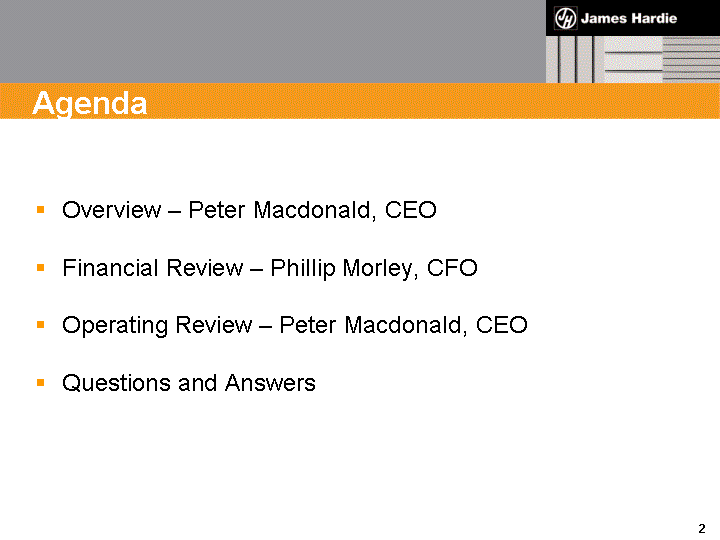
| Overview - Peter Macdonald, CEO Financial Review - Phillip Morley, CFO Operating Review - Peter Macdonald, CEO Questions and Answers Agenda |
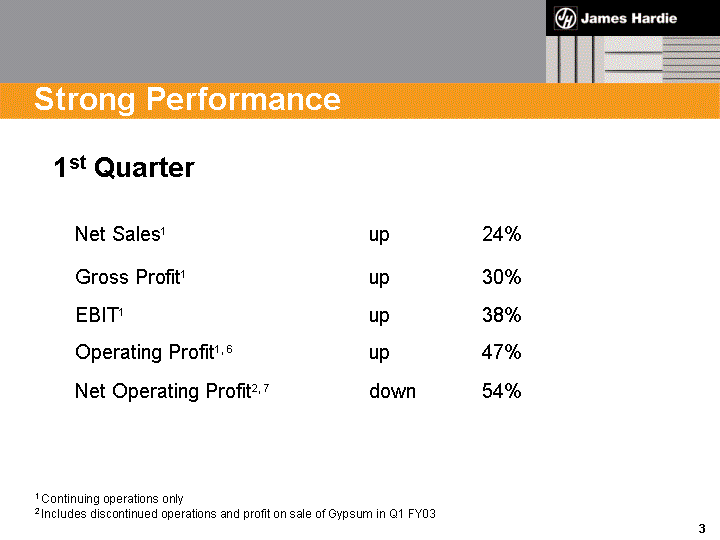
| 1 Continuing operations only 2 Includes discontinued operations and profit on sale of Gypsum in Q1 FY03 Strong Performance Net Sales1 up 24% Gross Profit1 up 30% EBIT1 up 38% Operating Profit1, 6 up 47% Net Operating Profit2, 7 down 54% 1st Quarter |
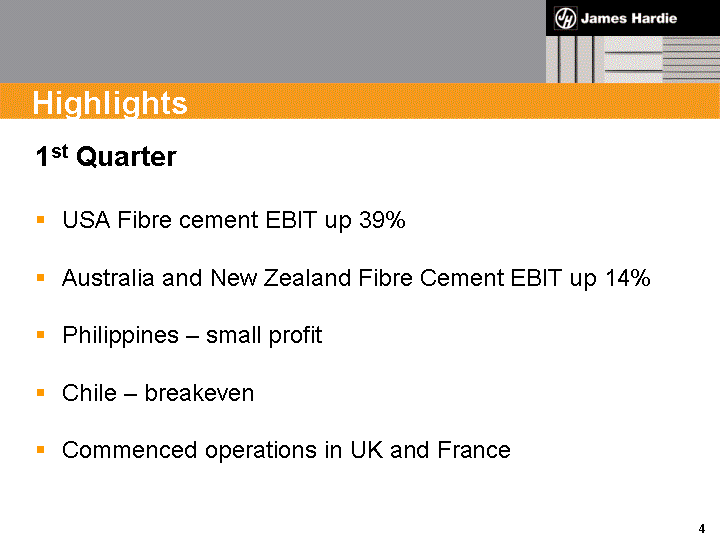
| Highlights 1st Quarter USA Fibre cement EBIT up 39% Australia and New Zealand Fibre Cement EBIT up 14% Philippines - small profit Chile - breakeven Commenced operations in UK and France |
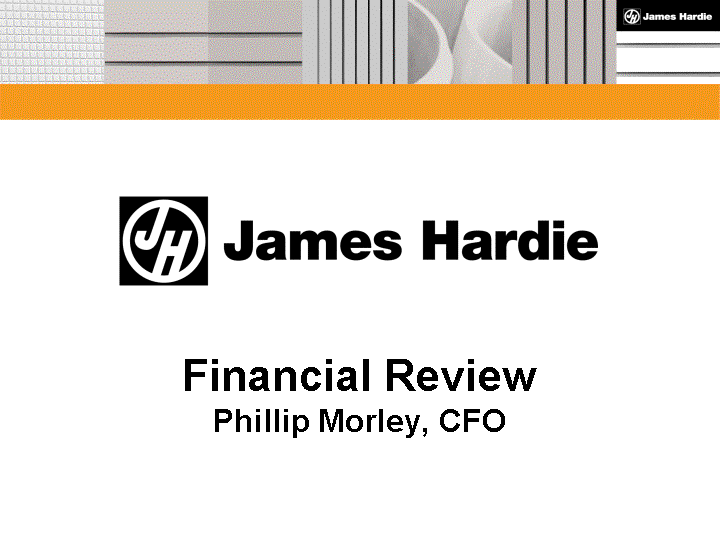
| Financial Review Phillip Morley, CFO |
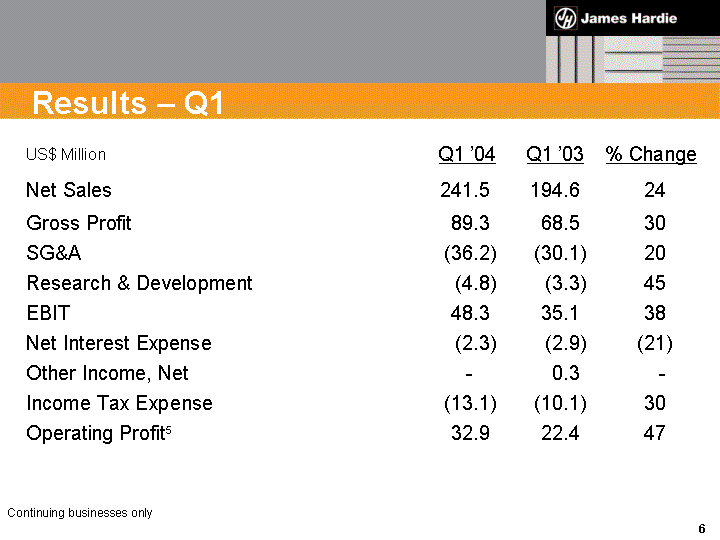
| US$ Million Q1 '04 Q1 '03 % Change Net Sales 241.5 194.6 24 Gross Profit 89.3 68.5 30 SG&A (36.2) (30.1) 20 Research & Development (4.8) (3.3) 45 EBIT 48.3 35.1 38 Net Interest Expense (2.3) (2.9) (21) Other Income, Net - 0.3 - Income Tax Expense (13.1) (10.1) 30 Operating Profit5 32.9 22.4 47 Continuing businesses only Results - Q1 |
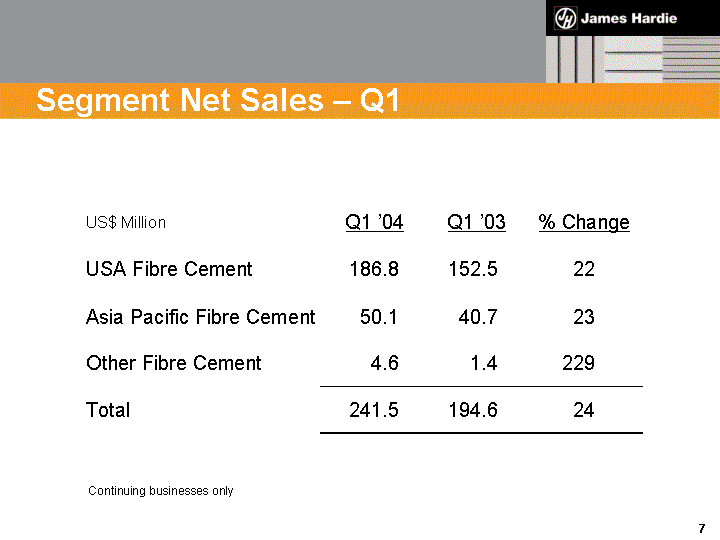
| Segment Net Sales - Q1 US$ Million Q1 '04 Q1 '03 % Change USA Fibre Cement 186.8 152.5 22 Asia Pacific Fibre Cement 50.1 40.7 23 Other Fibre Cement 4.6 1.4 229 Total 241.5 194.6 24 Continuing businesses only |
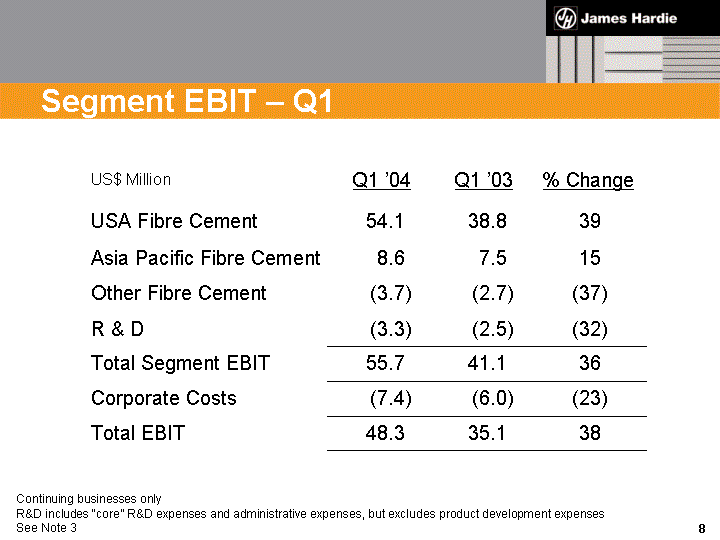
| Segment EBIT - Q1 US$ Million Q1 '04 Q1 '03 % Change USA Fibre Cement 54.1 38.8 39 Asia Pacific Fibre Cement 8.6 7.5 15 Other Fibre Cement (3.7) (2.7) (37) R & D (3.3) (2.5) (32) Total Segment EBIT 55.7 41.1 36 Corporate Costs (7.4) (6.0) (23) Total EBIT 48.3 35.1 38 Continuing businesses only R&D includes "core" R&D expenses and administrative expenses, but excludes product development expenses See Note 3 |
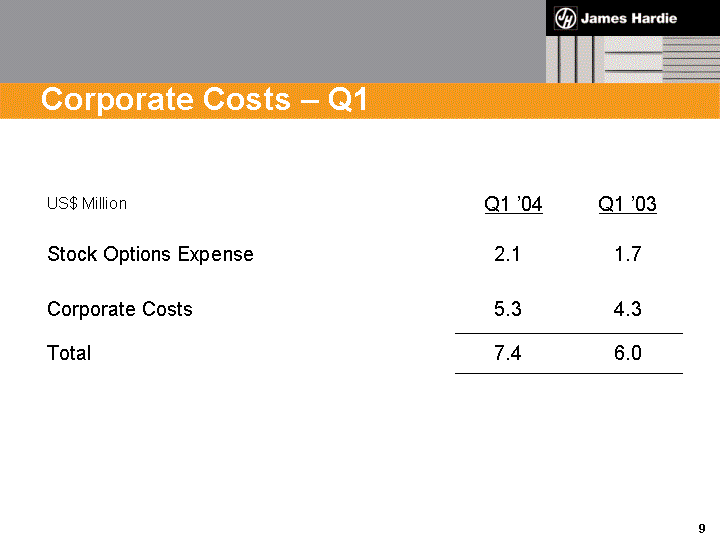
| Corporate Costs - Q1 US$ Million Q1 '04 Q1 '03 Stock Options Expense 2.1 1.7 Corporate Costs 5.3 4.3 Total 7.4 6.0 |
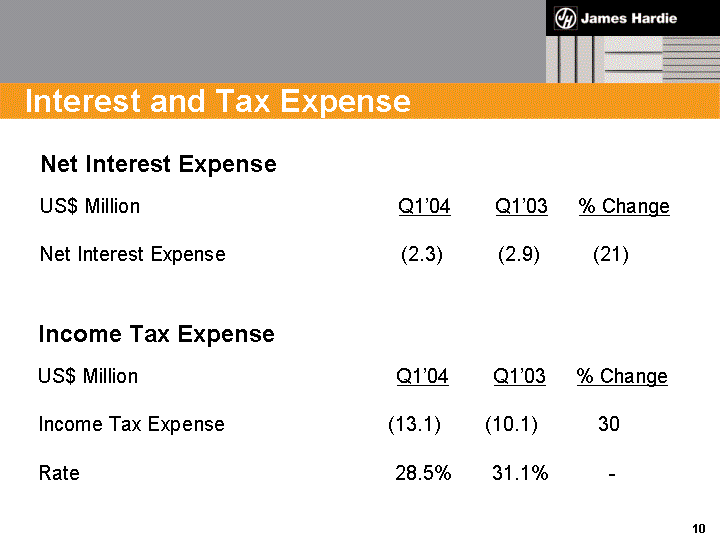
| Interest and Tax Expense Net Interest Expense Net Interest Expense Net Interest Expense Net Interest Expense US$ Million Q1'04 Q1'03 % Change Net Interest Expense (2.3) (2.9) (21) Income Tax Expense Income Tax Expense Income Tax Expense Income Tax Expense US$ Million Q1'04 Q1'03 % Change Income Tax Expense (13.1) (10.1) 30 Rate 28.5% 31.1% - |
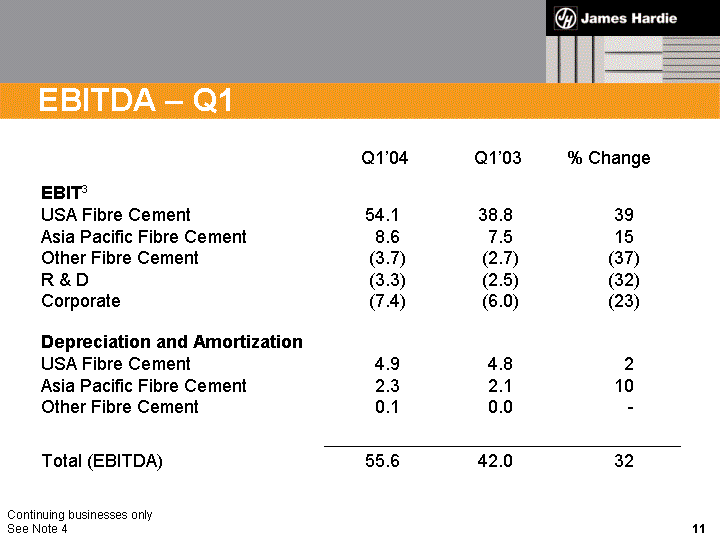
| EBITDA - Q1 Continuing businesses only See Note 4 Q1'04 Q1'03 % Change EBIT3 USA Fibre Cement Asia Pacific Fibre Cement Other Fibre Cement R & D Corporate 54.1 8.6 (3.7) (3.3) (7.4) 38.8 7.5 (2.7) (2.5) (6.0) 39 15 (37) (32) (23) Depreciation and Amortization USA Fibre Cement Asia Pacific Fibre Cement Other Fibre Cement 4.9 2.3 0.1 4.8 2.1 0.0 2 10 - Total (EBITDA) 55.6 42.0 32 |
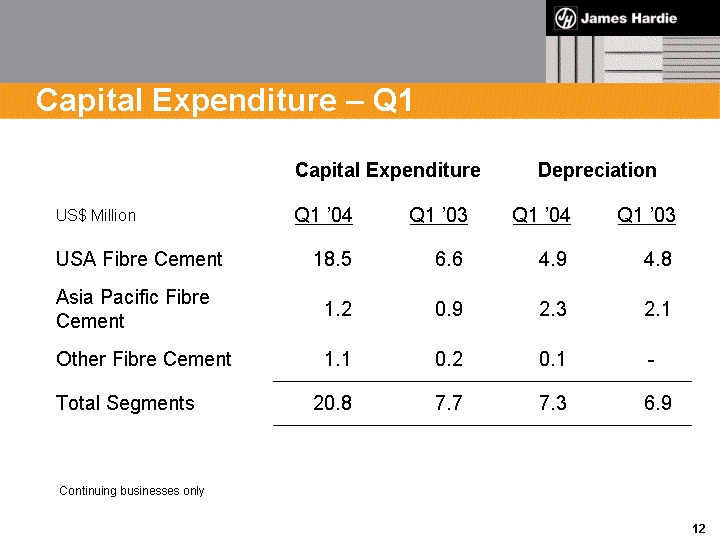
| Capital Expenditure - Q1 Capital Expenditure Capital Expenditure Depreciation Depreciation US$ Million Q1 '04 Q1 '03 Q1 '04 Q1 '03 USA Fibre Cement 18.5 6.6 4.9 4.8 Asia Pacific Fibre Cement 1.2 0.9 2.3 2.1 Other Fibre Cement 1.1 0.2 0.1 - Total Segments 20.8 7.7 7.3 6.9 Continuing businesses only |
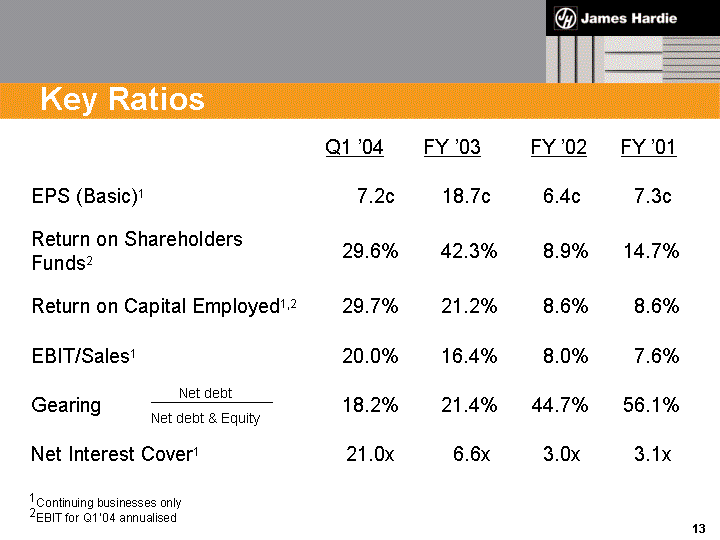
| Key Ratios Q1 '04 FY '03 FY '02 FY '01 EPS (Basic)1 7.2c 18.7c 6.4c 7.3c Return on Shareholders Funds2 29.6% 42.3% 8.9% 14.7% Return on Capital Employed1,2 29.7% 21.2% 8.6% 8.6% EBIT/Sales1 20.0% 16.4% 8.0% 7.6% Gearing 18.2% 21.4% 44.7% 56.1% Net Interest Cover1 21.0x 6.6x 3.0x 3.1x 1Continuing businesses only 2EBIT for Q1'04 annualised |
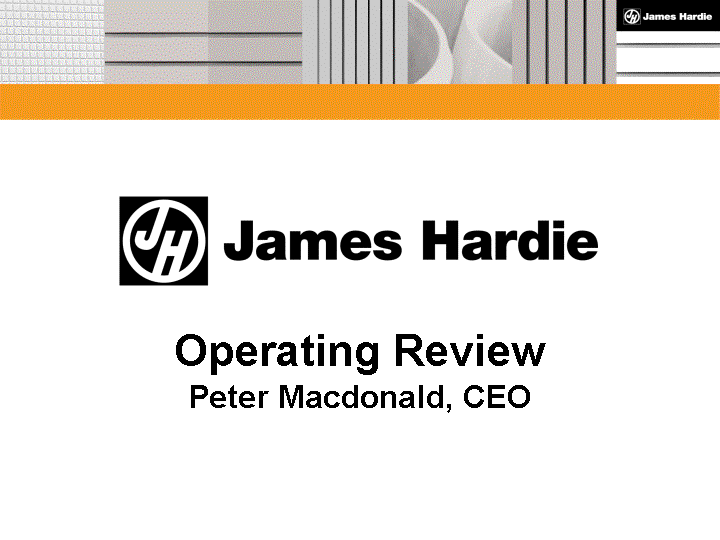
| Operating Review Peter Macdonald, CEO |
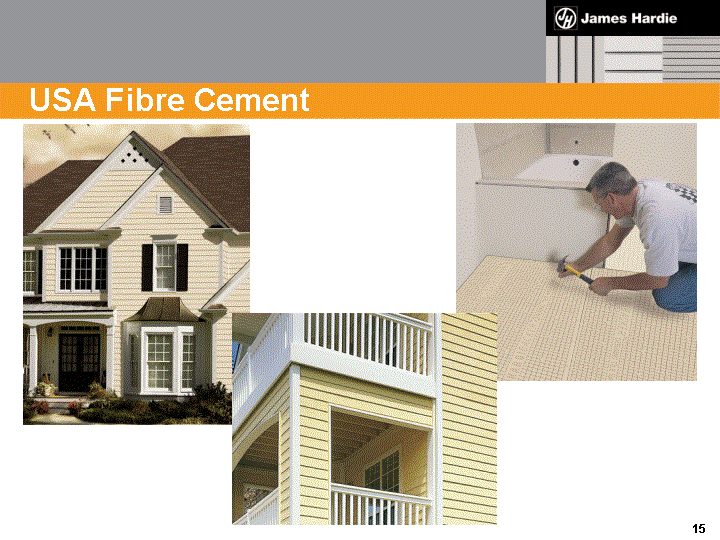
| USA Fibre Cement |

| Strong 1st Quarter Result Net Sales up 22% to US$186.8 million Sales Volume up 14% to 387.5 mmsf Average Price up 7% to US$482 per msf EBIT up 39% to US$54.1 million EBIT Margin up 3.6 pts to 29.0% USA Fibre Cement |
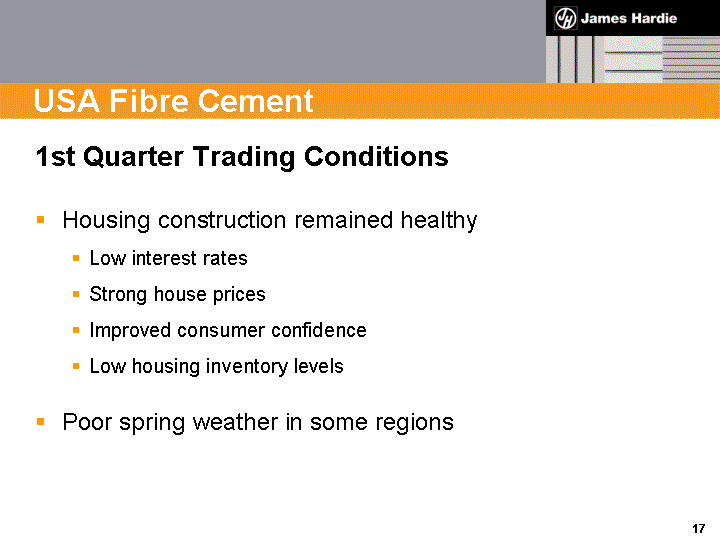
| USA Fibre Cement 1st Quarter Trading Conditions Housing construction remained healthy Low interest rates Strong house prices Improved consumer confidence Low housing inventory levels Poor spring weather in some regions |
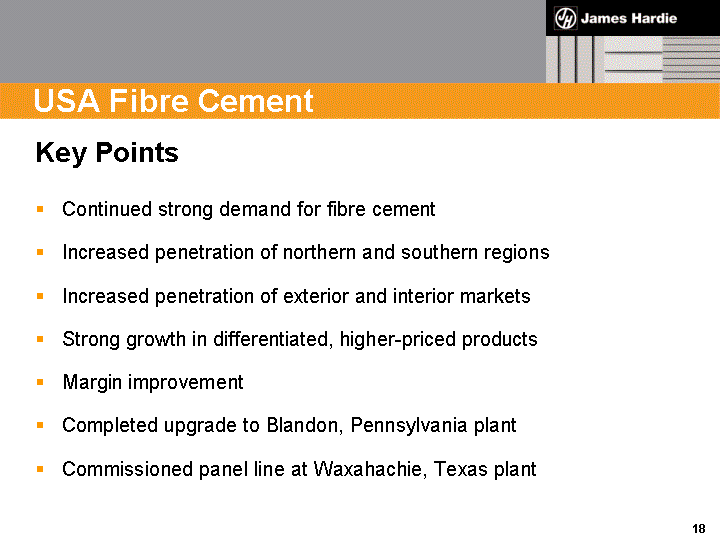
| USA Fibre Cement Key Points Continued strong demand for fibre cement Increased penetration of northern and southern regions Increased penetration of exterior and interior markets Strong growth in differentiated, higher-priced products Margin improvement Completed upgrade to Blandon, Pennsylvania plant Commissioned panel line at Waxahachie, Texas plant |

| USA Fibre Cement Revenue Growth Continuing to outstrip Volume Growth 0 200 400 600 800 1000 1200 1400 VOLUME (MMSF) 0 100 200 300 400 500 600 REVENUE (USDM) Volume Revenue 90 00 01 02 97 98 93 92 91 95 96 94 99 03 |
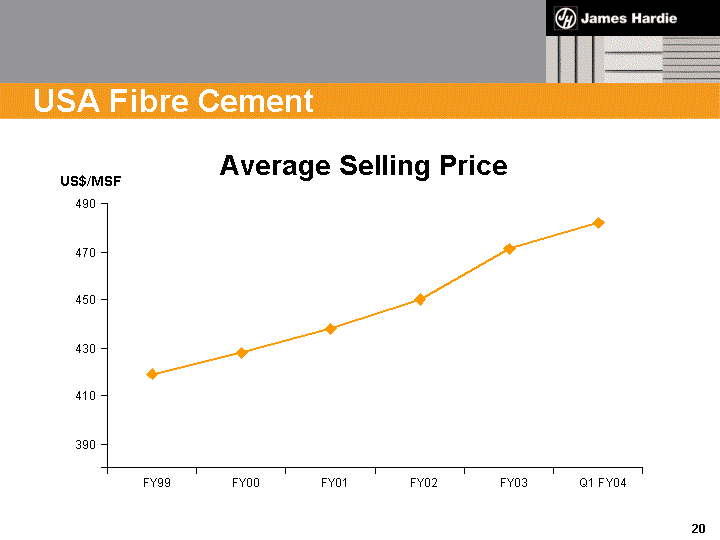
| USA Fibre Cement Average Selling Price 390 410 430 450 470 490 FY99 FY00 FY01 FY02 FY03 Q1 FY04 US$/MSF |
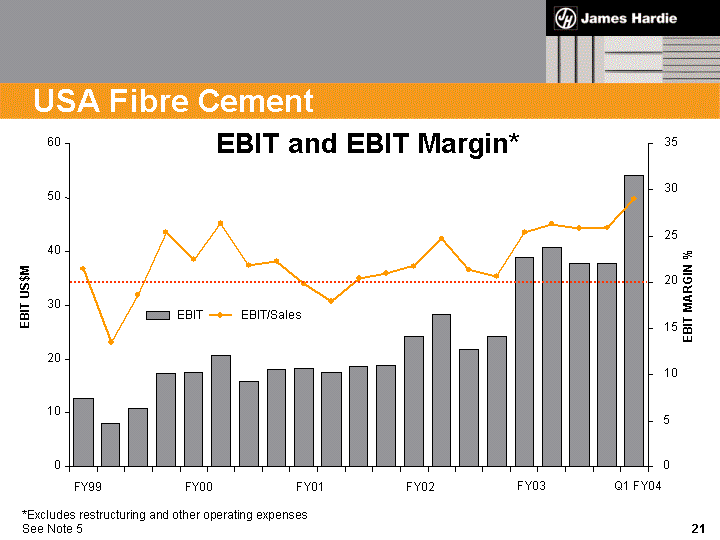
| USA Fibre Cement *Excludes restructuring and other operating expenses See Note 5 EBIT US$M 0 10 20 30 40 50 60 FY99 FY00 FY01 FY02 FY03 0 5 10 15 20 25 30 35 EBIT MARGIN % EBIT EBIT/Sales Q1 FY04 EBIT and EBIT Margin* |
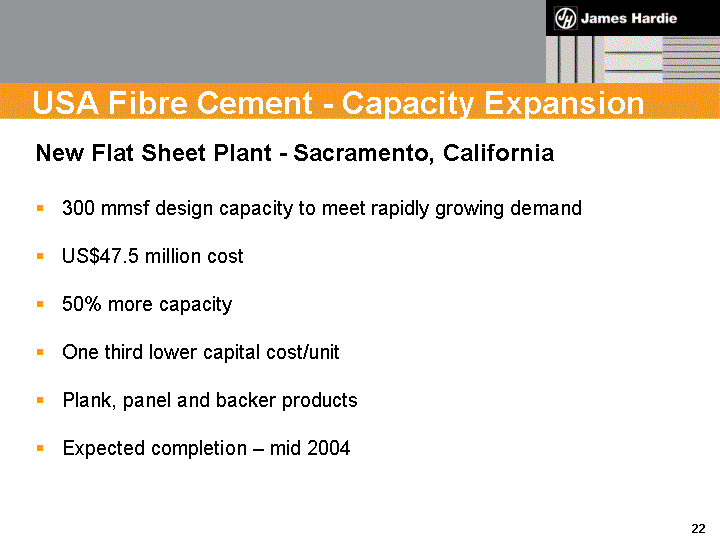
| USA Fibre Cement - Capacity Expansion New Flat Sheet Plant - Sacramento, California 300 mmsf design capacity to meet rapidly growing demand US$47.5 million cost 50% more capacity One third lower capital cost/unit Plank, panel and backer products Expected completion - mid 2004 |
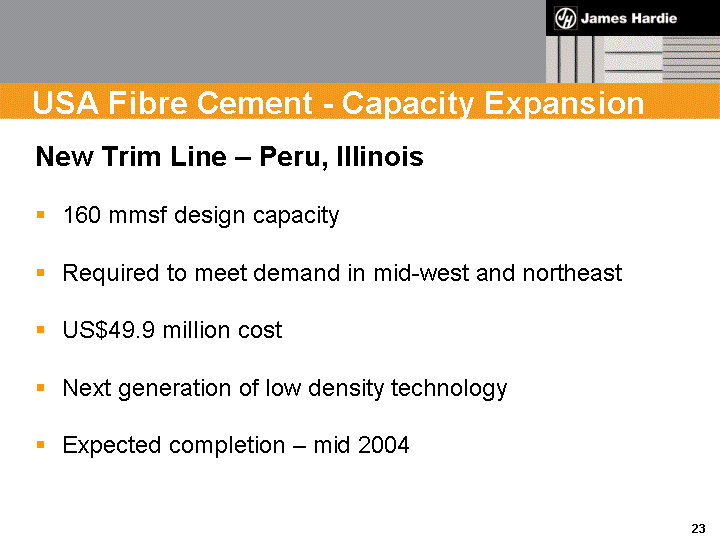
| New Trim Line - Peru, Illinois 160 mmsf design capacity Required to meet demand in mid-west and northeast US$49.9 million cost Next generation of low density technology Expected completion - mid 2004 USA Fibre Cement - Capacity Expansion |
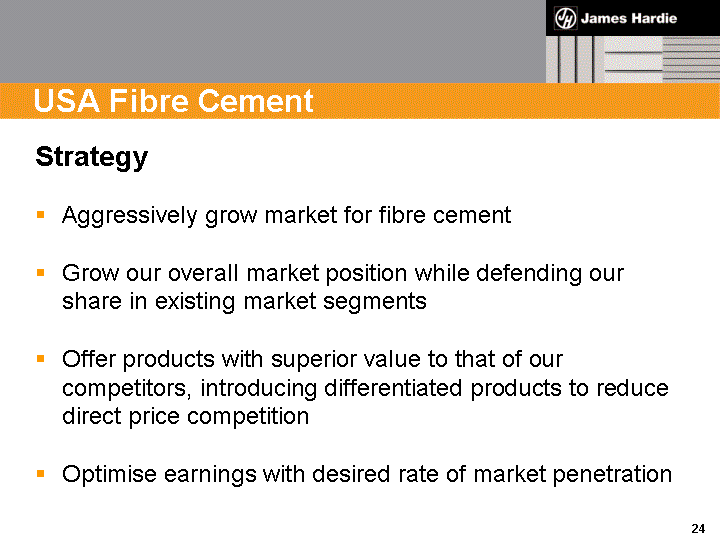
| USA Fibre Cement Strategy Aggressively grow market for fibre cement Grow our overall market position while defending our share in existing market segments Offer products with superior value to that of our competitors, introducing differentiated products to reduce direct price competition Optimise earnings with desired rate of market penetration |
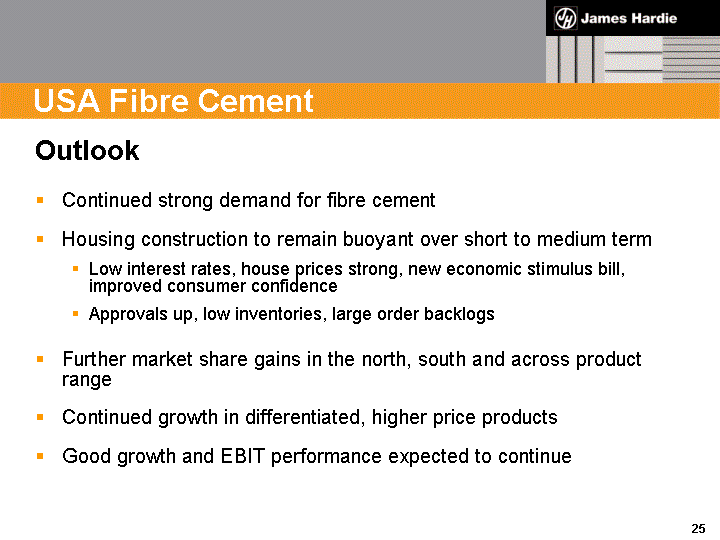
| USA Fibre Cement Outlook Continued strong demand for fibre cement Housing construction to remain buoyant over short to medium term Low interest rates, house prices strong, new economic stimulus bill, improved consumer confidence Approvals up, low inventories, large order backlogs Further market share gains in the north, south and across product range Continued growth in differentiated, higher price products Good growth and EBIT performance expected to continue |
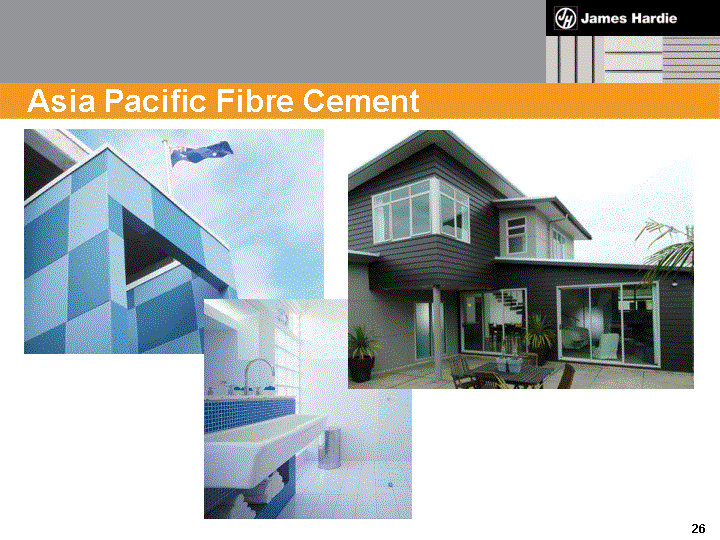
| Asia Pacific Fibre Cement |
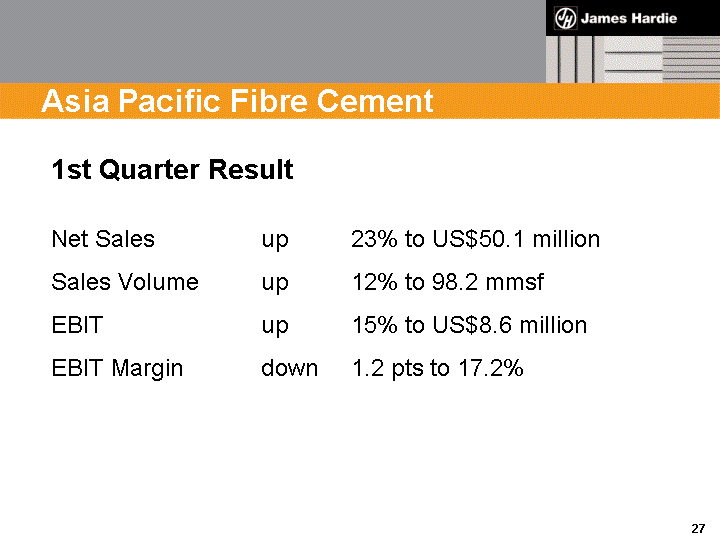
| 1st Quarter Result Net Sales up 23% to US$50.1 million Sales Volume up 12% to 98.2 mmsf EBIT up 15% to US$8.6 million EBIT Margin down 1.2 pts to 17.2% Asia Pacific Fibre Cement |
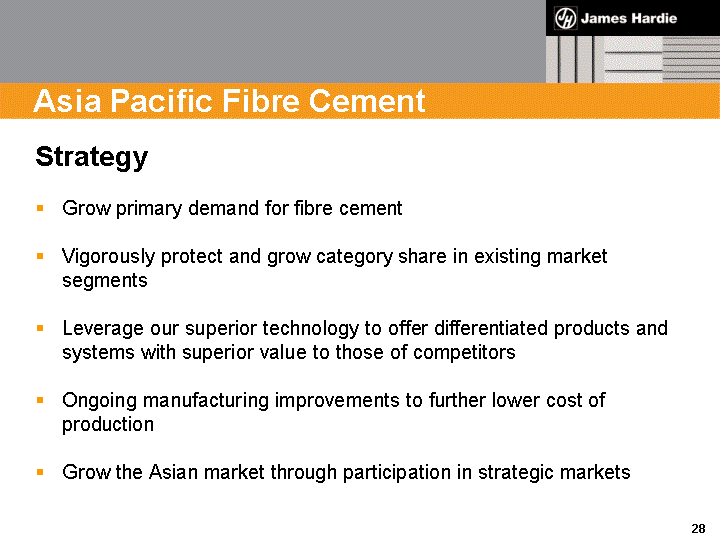
| Asia Pacific Fibre Cement Strategy Grow primary demand for fibre cement Vigorously protect and grow category share in existing market segments Leverage our superior technology to offer differentiated products and systems with superior value to those of competitors Ongoing manufacturing improvements to further lower cost of production Grow the Asian market through participation in strategic markets |
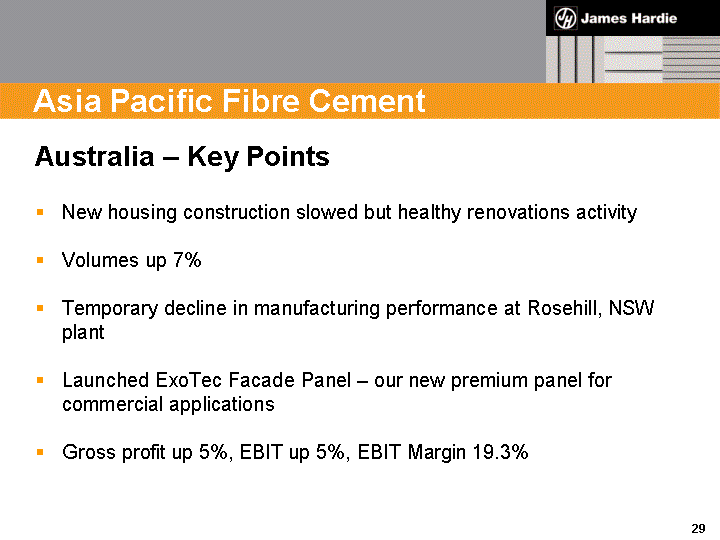
| Asia Pacific Fibre Cement Australia - Key Points New housing construction slowed but healthy renovations activity Volumes up 7% Temporary decline in manufacturing performance at Rosehill, NSW plant Launched ExoTec Facade Panel - our new premium panel for commercial applications Gross profit up 5%, EBIT up 5%, EBIT Margin 19.3% |
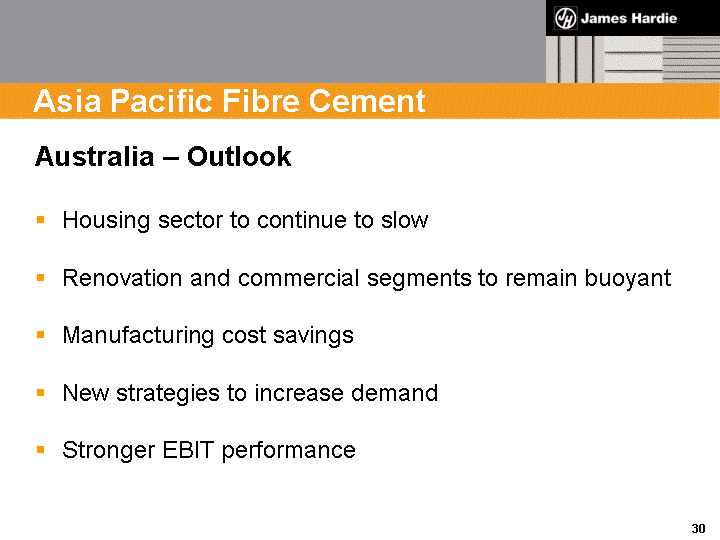
| Asia Pacific Fibre Cement Australia - Outlook Housing sector to continue to slow Renovation and commercial segments to remain buoyant Manufacturing cost savings New strategies to increase demand Stronger EBIT performance |
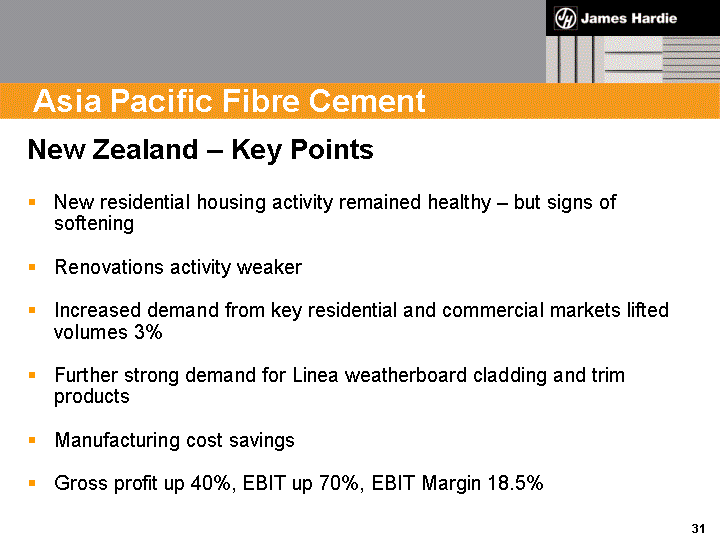
| Asia Pacific Fibre Cement New Zealand - Key Points New residential housing activity remained healthy - but signs of softening Renovations activity weaker Increased demand from key residential and commercial markets lifted volumes 3% Further strong demand for Linea weatherboard cladding and trim products Manufacturing cost savings Gross profit up 40%, EBIT up 70%, EBIT Margin 18.5% |
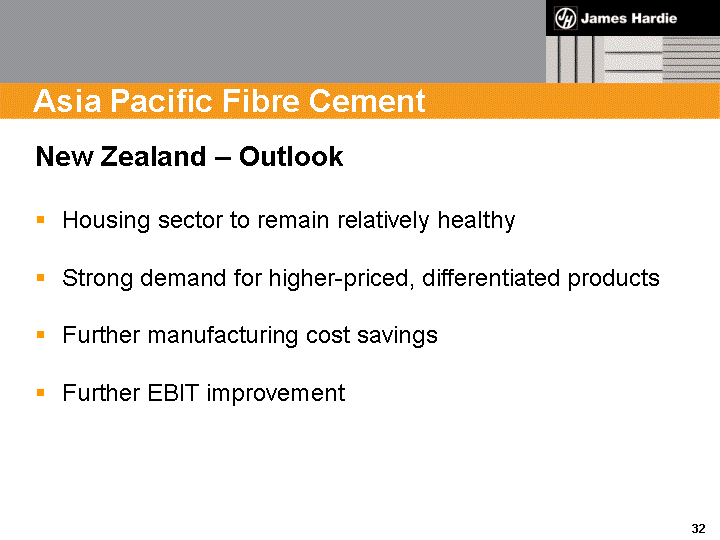
| Asia Pacific Fibre Cement New Zealand - Outlook Housing sector to remain relatively healthy Strong demand for higher-priced, differentiated products Further manufacturing cost savings Further EBIT improvement |
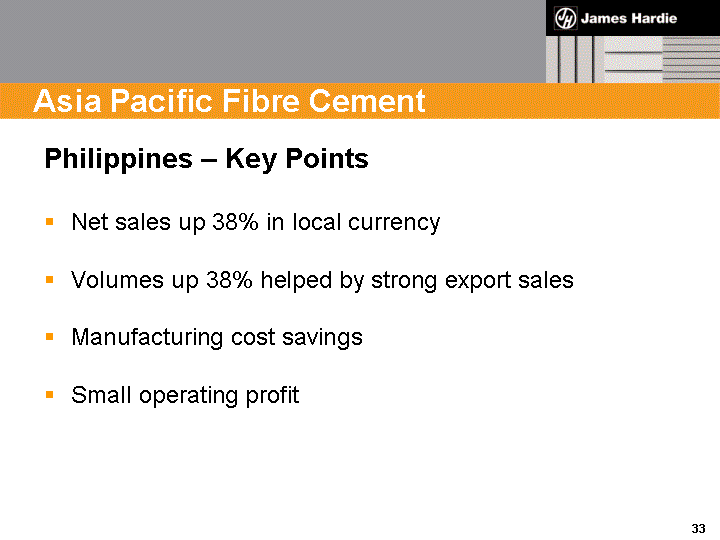
| Asia Pacific Fibre Cement Philippines - Key Points Net sales up 38% in local currency Volumes up 38% helped by strong export sales Manufacturing cost savings Small operating profit |
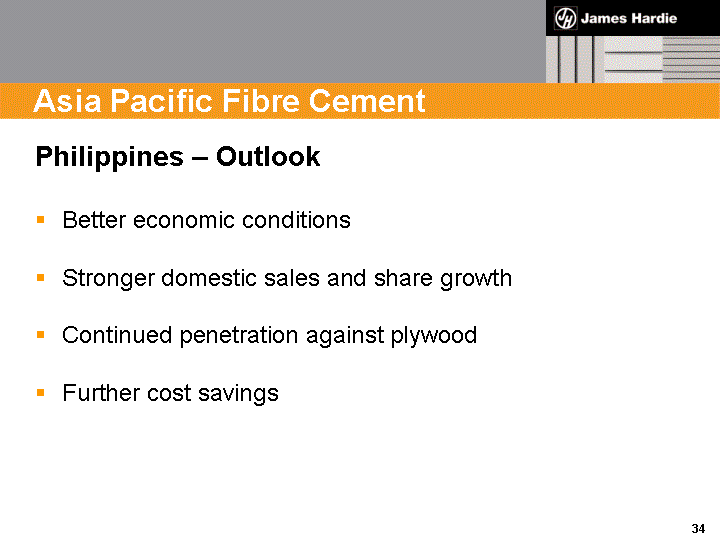
| Asia Pacific Fibre Cement Philippines - Outlook Better economic conditions Stronger domestic sales and share growth Continued penetration against plywood Further cost savings |
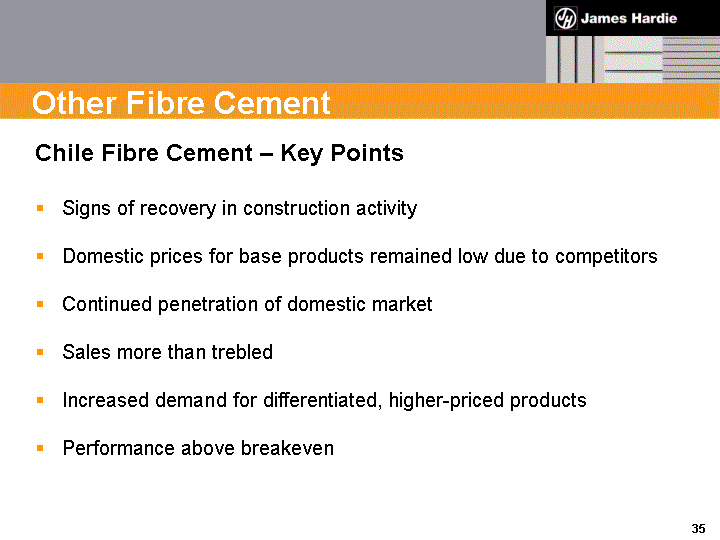
| Other Fibre Cement Chile Fibre Cement - Key Points Signs of recovery in construction activity Domestic prices for base products remained low due to competitors Continued penetration of domestic market Sales more than trebled Increased demand for differentiated, higher-priced products Performance above breakeven |

| Other Fibre Cement Chile Fibre Cement - Outlook Entering normal seasonal industry slowdown Further market penetration and share growth Increased sales of differentiated, higher-priced products Prices for base products to remain low due to competitors |
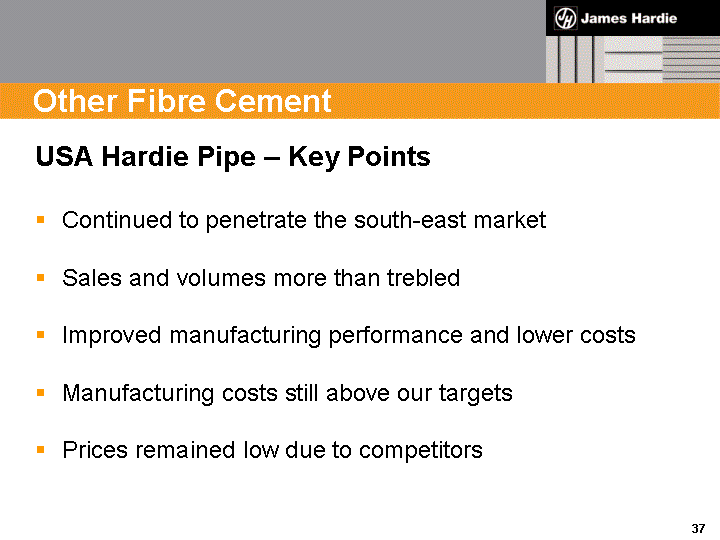
| Other Fibre Cement USA Hardie Pipe - Key Points Continued to penetrate the south-east market Sales and volumes more than trebled Improved manufacturing performance and lower costs Manufacturing costs still above our targets Prices remained low due to competitors |
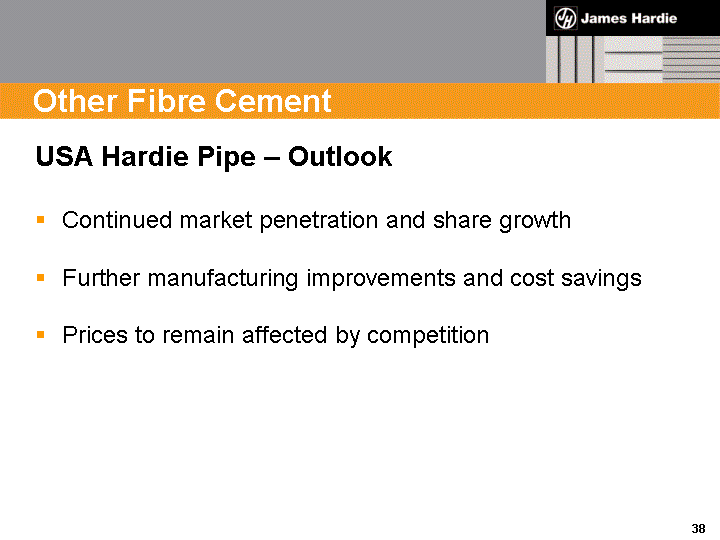
| Other Fibre Cement USA Hardie Pipe - Outlook Continued market penetration and share growth Further manufacturing improvements and cost savings Prices to remain affected by competition |
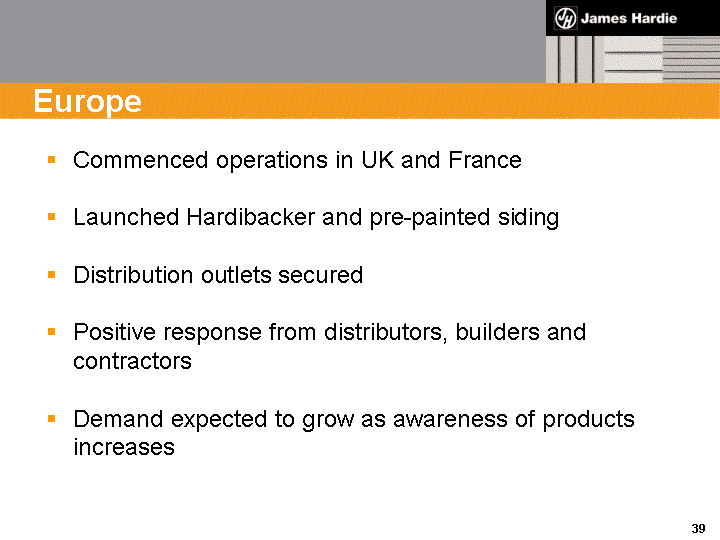
| Europe Commenced operations in UK and France Launched Hardibacker and pre-painted siding Distribution outlets secured Positive response from distributors, builders and contractors Demand expected to grow as awareness of products increases |
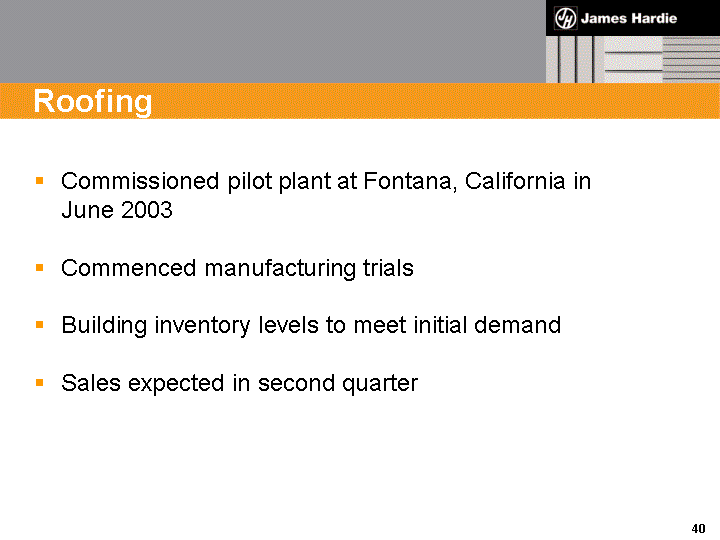
| Roofing Commissioned pilot plant at Fontana, California in June 2003 Commenced manufacturing trials Building inventory levels to meet initial demand Sales expected in second quarter |
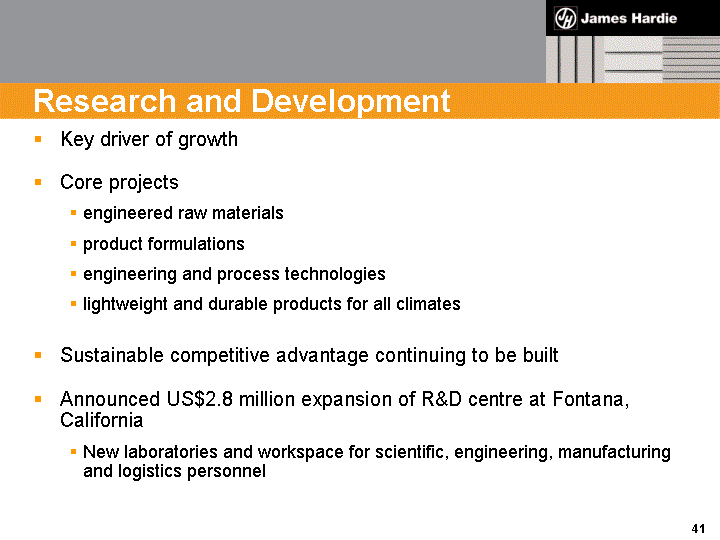
| Research and Development Key driver of growth Core projects engineered raw materials product formulations engineering and process technologies lightweight and durable products for all climates Sustainable competitive advantage continuing to be built Announced US$2.8 million expansion of R&D centre at Fontana, California New laboratories and workspace for scientific, engineering, manufacturing and logistics personnel |

| Outlook Strong results in Q1 continuing into Q2 Prospects for good growth over the full year are encouraging |
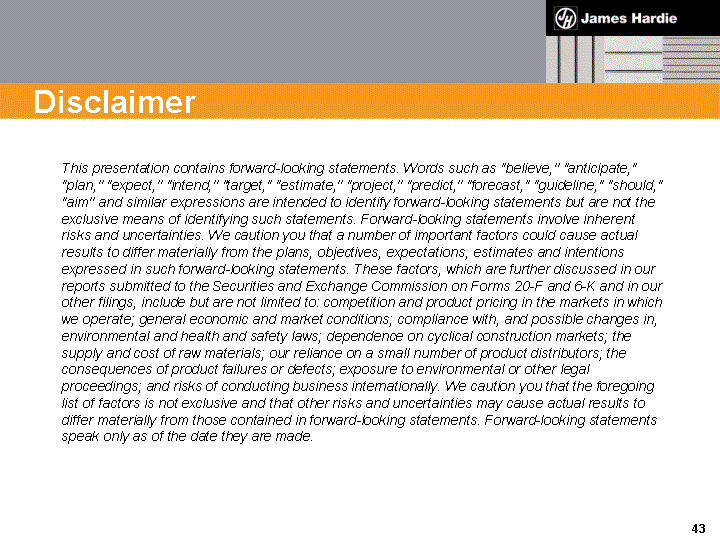
| Disclaimer This presentation contains forward-looking statements. Words such as “believe,” “anticipate,” “plan,” “expect,” “intend,” “target,” “estimate,” “project,” “predict,” “forecast,” “guideline,” “should,” “aim” and similar expressions are intended to identify forward-looking statements but are not the exclusive means of identifying such statements. Forward-looking statements involve inherent risks and uncertainties. We caution you that a number of important factors could cause actual results to differ materially from the plans, objectives, expectations, estimates and intentions expressed in such forward-looking statements. These factors, which are further discussed in our reports submitted to the Securities and Exchange Commission on Forms 20-F and 6-K and in our other filings, include but are not limited to: competition and product pricing in the markets in which we operate; general economic and market conditions; compliance with, and possible changes in, environmental and health and safety laws; dependence on cyclical construction markets; the supply and cost of raw materials; our reliance on a small number of product distributors; the consequences of product failures or defects; exposure to environmental or other legal proceedings; and risks of conducting business internationally. We caution you that the foregoing list of factors is not exclusive and that other risks and uncertainties may cause actual results to differ materially from those contained in forward-looking statements. Forward-looking statements speak only as of the date they are made. |
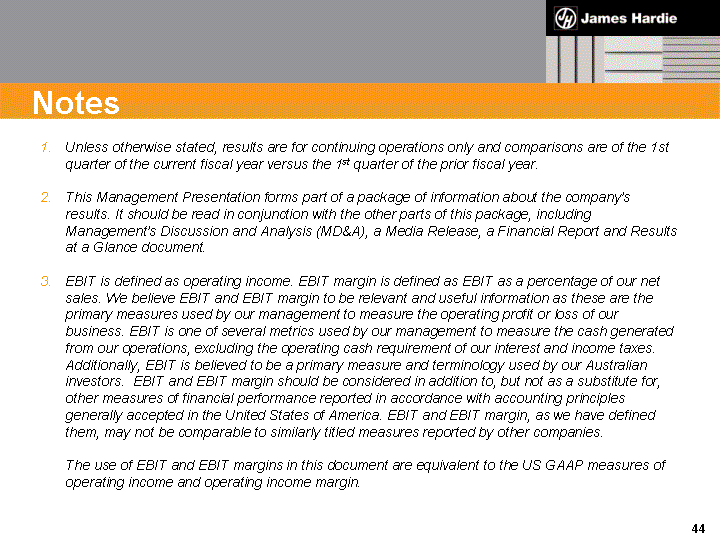
| Notes Unless otherwise stated, results are for continuing operations only and comparisons are of the 1st quarter of the current fiscal year versus the 1st quarter of the prior fiscal year. This Management Presentation forms part of a package of information about the company's results. It should be read in conjunction with the other parts of this package, including Management's Discussion and Analysis (MD&A), a Media Release, a Financial Report and Results at a Glance document. EBIT is defined as operating income. EBIT margin is defined as EBIT as a percentage of our net sales. We believe EBIT and EBIT margin to be relevant and useful information as these are the primary measures used by our management to measure the operating profit or loss of our business. EBIT is one of several metrics used by our management to measure the cash generated from our operations, excluding the operating cash requirement of our interest and income taxes. Additionally, EBIT is believed to be a primary measure and terminology used by our Australian investors. EBIT and EBIT margin should be considered in addition to, but not as a substitute for, other measures of financial performance reported in accordance with accounting principles generally accepted in the United States of America. EBIT and EBIT margin, as we have defined them, may not be comparable to similarly titled measures reported by other companies. The use of EBIT and EBIT margins in this document are equivalent to the US GAAP measures of operating income and operating income margin. |
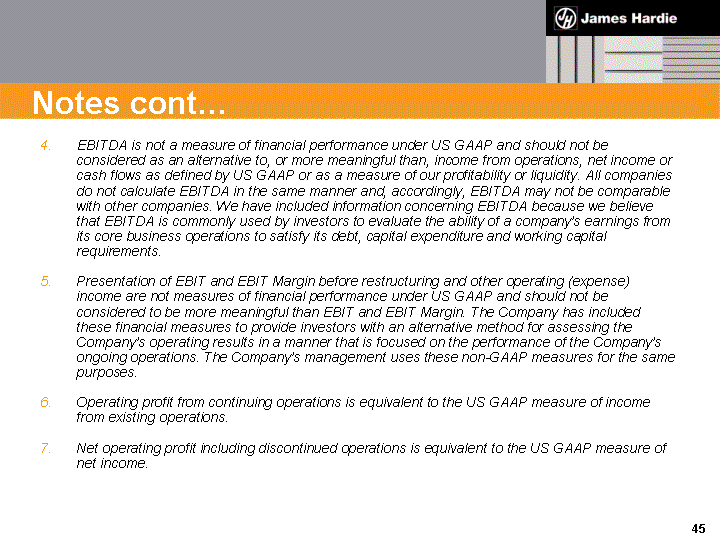
| Notes cont... 4. EBITDA is not a measure of financial performance under US GAAP and should not be considered as an alternative to, or more meaningful than, income from operations, net income or cash flows as defined by US GAAP or as a measure of our profitability or liquidity. All companies do not calculate EBITDA in the same manner and, accordingly, EBITDA may not be comparable with other companies. We have included information concerning EBITDA because we believe that EBITDA is commonly used by investors to evaluate the ability of a company's earnings from its core business operations to satisfy its debt, capital expenditure and working capital requirements. Presentation of EBIT and EBIT Margin before restructuring and other operating (expense) income are not measures of financial performance under US GAAP and should not be considered to be more meaningful than EBIT and EBIT Margin. The Company has included these financial measures to provide investors with an alternative method for assessing the Company's operating results in a manner that is focused on the performance of the Company's ongoing operations. The Company's management uses these non-GAAP measures for the same purposes. Operating profit from continuing operations is equivalent to the US GAAP measure of income from existing operations. Net operating profit including discontinued operations is equivalent to the US GAAP measure of net income. |
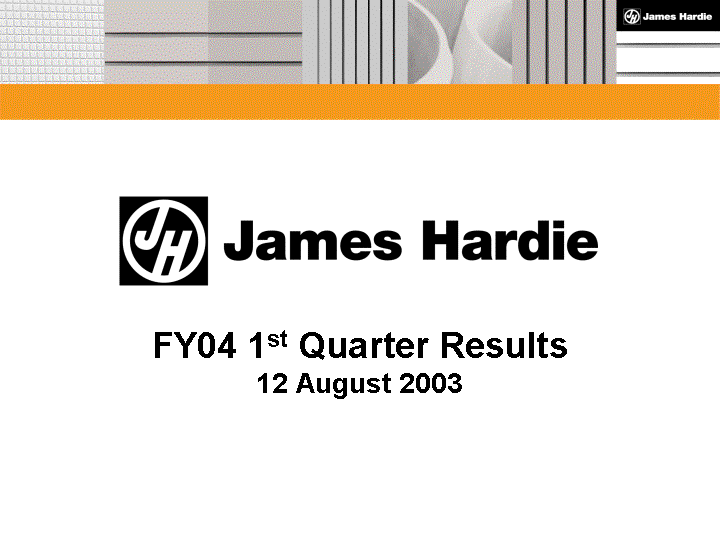
| FY04 1st Quarter Results 12 August 2003 |